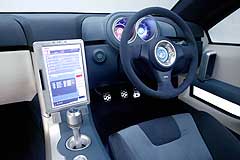Make / Model Search
Future models - Toyota - Sportivo Coupe conceptFirst drive: Toyota’s concept has fiery heartLight my fire: Under the impressively fierce bodywork beats a heart that could and should find its way into future production Toyotas. Pics courtesy New Zealand Autocar. The Sportivo concept offers glimmers of a more exciting future for Toyota Australia15 Jun 2004 By BRUCE NEWTON AS drives go we would never presume to claim this as one of our most extensive or emphatic, but as an eye-opener to the future our experience of the Toyota Sportivo concept at Melbourne’s Sandown racetrack proved to be very revealing. If you haven’t heard of the Sportivo concept by now then you obviously live somewhere very remote, where even Toyota’s all pervasive spin doctors cannot penetrate. But for once the PR merchants do not have to go overboard to hype a Toyota product because the Sportivo is undoubtedly as significant as they come. It’s the second concept car Toyota Australia has built, following precisely 12 months after the all-wheel X-Runner utility, which made its debut at the Melbourne motor show in 2003. Sportivo goes a big step further, cloaked in a swooping carbon-fibre body complete with dihedral doors, it was designed by Nick Hogios, the former young designer of the year award winner who swapped from Ford to Toyota after leading the BA XR design program. There’s little production car relationship in the shape to any current or future Toyota product. It’s not the next Toyota Celica, or a future Camry coupe. Toyota Style Australia boss Paul Beranger will only concede there is a "hint" of the future in some style elements. We’re betting on the headlights and grille as fitting that bill, while classic concept car cues like the exaggerated fenders and massive 21-inch wheels and tyres along with the 380 LED lights won’t be seen anywhere soon.  Inside it’s just as outlandish, featuring a bespoke four-seat interior that has a d river-centric cockpit area, including a flat-screen instrument panel, push-button start, a drivers’ seat design with different contours and a four-point harness. Inside it’s just as outlandish, featuring a bespoke four-seat interior that has a d river-centric cockpit area, including a flat-screen instrument panel, push-button start, a drivers’ seat design with different contours and a four-point harness.While Mr Hogios was in charge of the look, Mr Beranger ran the project, which followed an unusual and incredibly short creation process. From go to whoa it took 30 weeks, and rather than following the traditional design process Toyota wanted Sportivo to reflect the thoughts of future generations of car buyers. So what the Sportivo became is driven very much by the feedback of 100 14 to 18-year-old Sydney and Melbourne teenagers. "Personal mobility and communications were what came out as being very important," said Mr Beranger. "They saw the use of the car as being an urban mobility thing, although some of them wanted to have a bit more of a race around and enjoy the performance, so it was a bit of a balance." Intrinsic to all that is a telematics system called T-Link. This is based around the driver’s license, which is a mobile phone-style SIM card that would be embedded with a host of data. The licence would not only allow the driver access to the car, but also provides individual settings for driving position, radio stations, phone numbers, GPS tracking data for friends and even engine output. The system even allows the personal electronic licence number of the driver to be displayed on the number plate, as well as P, L or handicap plates if applicable. Toyota says speeding fines, tollway charges and even parking fines could be sent through T-Link to the driver responsible, rather than the car owner. The drivetrain also has very much a youthfull skew. Underpinning it all is a ‘Hokkaido’ specification Camry platform which employs the all-wheel drive system from the RAV4 compact soft-roader. Where the local engineering comes in is the turbocharging of the familiar 2AZ-FE 2.4-litre four-cylinder engine and its combination with a five-speed manual gearbox rather than the standard four-speed auto. Turbocharging work was done by Toyota Australia supplier APS and despite minimal dyno and sorting time, power was improved from 112kW to 180kW and torque from 218Nm at 305Nm. Mechanically, other areas remain fundamentally as before. Suspension changes were limited to reset springs, the Aisin steering rack has been repositioned higher in the subframe to allow for the manual gearbox, the clutch is bog stock. Understandably, the brakes have been upsized courtesy of PBR. All up, Sportivo was a $1 million-plus job, although specific accounting is hard to do because of the number of people who swung in and out of the project, including suppliers. Of course this car did not have a sole intent of simply talking to kids. It’s much more multi-purpose than that. It also hypes the Sportivo name. That’s significant, because if we read our tea leaves correctly Toyota should be using more of Sportivo soon, with plans to establish a HSV-like special vehicles division gestating this year. There were other objectives too. The concept was intended as an advertisement to aspiring designers and engineers that you didn’t have to only look to Holden and Ford for challenging and creative automotive work in Australia. And also to forcefully remind Toyota headquarters in Japan of the ability that exists down here. The car heads to Japan soon for close-up inspection at Toyota City, so tick off that as one objective completed. DRIVE IMPRESSIONS:RATE a concept by production car standards and you’d very quickly dismiss it as a disaster. But the point of good concepts is to reveal and stimulate, trigger discussion and debate as it hints to the future.Full marks to the Sportivo concept on that basis then, once you get over its various idiosyncrasies. First off is the din. Induction and wastegate noise is spectacular thanks to the use of a racing-type inline air filter and lack of sound deadening, simply areas the build team at Toyota in Melbourne never got around to addressing. Then there’s the steering wheel, which sits too low because the powered column only goes down the drivers’ seat is built for looks not comfort and the passenger door doesn’t work. There’s an array of wires bursting out from under the dashboard the cap has come unglued from the alloy gear shift and without winding windows or air-conditioning, the car’s extensive amount of glass area makes it a hot and sweaty environment. But all that can’t disguise how good the engine actually is – no wonder Toyota is considering this engine as a part of the next generation Camry’s Sportivo range. At idle there is no roughness and under acceleration there is no lumpiness, merely a welling of power that our Toyota-enforced 80km/h limit abruptly quells. It does take a while for the revs to die away on the over-run above 3000rpm but that’s a set-up issue that can’t disguise the engine’s potential. Acceleration is real shove-in-the-back stuff, but lacking in the lag you might expect. There’s much more potential in this unit apparently, which is very good news. The standard gearbox and clutch cope well with stops and starts and shift quickly and smoothly up through the gears with nary a problem. Hard to believe this is a one-off, the lack of clunking and whirring through the all-wheel drivetrain is quite remarkable. Even on its huge rubber, Sportivo rides quite smoothly despite the massive low-profile rubber. Naturally, grip is fine and braking strong. Steering is surprisingly accurate, although the turning circle seems ponderous. Of course, those comments are couched within the context of a smooth and grippy racetrack. But for all the conditions and concessions imposed on such a drive, there’s certainly no doubt that under the impressively fierce bodywork beats a heart that could and should find its way into future production Toyotas. As already stated, the Sportivo serves many purposes and based on this experience has the potential to perform the actual core component – being a motor car – really well. Yep, very revealing stuff. All future modelsMotor industry news |
Click to shareToyota modelsResearch Toyota All future modelsMotor industry news |

 Alfa Romeo
Alfa Romeo Abarth
Abarth Audi
Audi Aston Martin
Aston Martin BMW
BMW Bentley
Bentley Ferrari
Ferrari Chevrolet
Chevrolet Ford
Ford Fiat
Fiat GWM
GWM Foton
Foton Hyundai
Hyundai Honda
Honda Jaguar
Jaguar Isuzu
Isuzu Kia
Kia Jeep
Jeep Land Rover
Land Rover Lamborghini
Lamborghini Maserati
Maserati Lexus
Lexus McLaren
McLaren Mazda
Mazda Mercedes-Benz
Mercedes-Benz Mitsubishi
Mitsubishi Mini
Mini Peugeot
Peugeot Nissan
Nissan Ram
Ram Porsche
Porsche Rolls-Royce
Rolls-Royce Smart
Smart Skoda
Skoda Suzuki
Suzuki Subaru
Subaru Toyota
Toyota Tesla
Tesla Volvo
Volvo Zeekr
Zeekr







Facebook Twitter Instagram